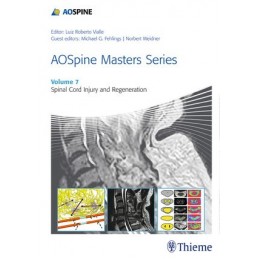- Obniżka


 Dostawa
Dostawa
Wybierz Paczkomat Inpost, Orlen Paczkę, DHL, DPD, Pocztę, email (dla ebooków). Kliknij po więcej
 Płatność
Płatność
Zapłać szybkim przelewem, kartą płatniczą lub za pobraniem. Kliknij po więcej szczegółów
 Zwroty
Zwroty
Jeżeli jesteś konsumentem możesz zwrócić towar w ciągu 14 dni*. Kliknij po więcej szczegółów
World-renowned experts share the latest updates in translational research as well as surgical and nonsurgical strategies for treating spinal cord injury
Spinal cord injury (SCI) is a devastating, clinically challenging injury, leading to varying degrees of neurological function impairment and paralysis. Underlying biological mechanisms either inhibit or promote new growth in the spinal cord. Researchers have been making important discoveries about how neurons and their axons grow in the central nervous system and why they fail to regenerate after SCI. Although progress has been steady, there remains an urgent need to address issues in acute management such as early decompression and the use of biologics, as well as potential solutions for regeneration.
Written by renowned experts in the ever-evolving field of SCI research and clinical practice, the 7th volume in the AOSpine Masters series is a state-of-the-art compendium on the latest in SCI diagnosis, spine surgery interventions, and long-term management. Each chapter contains pearls from leading spine specialists gleaned from the research laboratory and years of hands-on experience treating SCI patients in the emergency setting and long term.
Key Features::
The AOSpine Masters series, a copublication of Thieme and the AOSpine Foundation, addresses current clinical issues featuring international masters sharing their expertise in the core areas in the field. The goal of the series is to contribute to an evolving, dynamic model of evidence-based approach to spine care.
This essential textbook delivers invaluable insights to spine surgeons, spinal cord injury clinicians and researchers and trainees, from translational researchers to experienced researchers and clinicians experienced in the operative and non-operative management of spinal cord injury.
Opis
1. Pathobiology of Spinal Cord Injury
2. Assessment of Functional Status and Outcomes of Individuals with Traumatic Spinal Cord Injury
3. Serum and CSF Biomarkers to Predict Functional Recovery After Spinal Cord Injury
4. Magnetic Resonance Imaging of the Injured Spinal Cord: The Present and the Future
5. Acute Nonoperative Management of Traumatic Spinal Cord Injury: State of the Art
6. Role and Timing of Surgery for Traumatic Spinal Cord Injury: What Do We Know and What Should We Do?
7. Methylprednisolone As a Valid Option for Acute Spinal Cord Injury: A Reassessment of the Literature
8. Neuroprotection of the Injured Spinal Cord: What Does the Future Hold?
9. Hydrogel Biomaterials in Spinal Cord Repair and Regeneration
10. Neural Stem Cell Transplantation for Spinal Cord Repair
11. Strategies to Overcome the Inhibitory Environment of the Spinal Cord
12. Functional Electrical Stimulation and Neuromodulation Approaches to Enhance Recovery After Spinal Cord Injury
13. Advanced Rehabilitation Strategies for Individuals with Traumatic Spinal Cord Injury
14. Brain-Computer Interfaces to Enhance Function After Spinal Cord Injury
Indeks: 56439
Autor: Luiz Roberto Gomes Vialle
Indeks: 56955
Autor: Luiz Roberto Gomes Vialle
Indeks: 57492
Autor: Alexander R. Vaccaro
Indeks: 57798
Autor: Luiz Roberto Gomes Vialle
Indeks: 80278
Autor: Marinus de Kleuver
Indeks: 80359
Autor: Shanmuganathan Rajasekaran
Indeks: 70650
Autor: Dean T. Jamison
Indeks: 35758
Autor: David Goldberg
Text with DVD: Vascular, Pigmentation, Scars, Medical Applications
